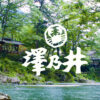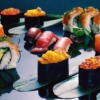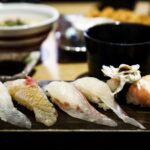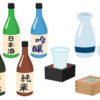Way to drink Japanese sake? Familiarize yourself with the different types of sake.
Do you know any types of sake? We will explain Junmai and DaiーGinjo in an easily understandable way.
“Sake" is an alcoholic beverage which is representing Japan. There are various types and the hurdles are a little high for beginners of sake. For those who are contemplating what type of sake to drink or purchase, We will gradually explain the types of sake!

Contents
1. The simplest explanation of the types of sake!
2. What is 清酒SeiーShu (Sake) in the first place?
3. What is the 精米歩合SeimaiーBuai(rice polishing rate)?
4. What is the difference between 吟醸Ginjo and 大吟醸DaiーGinjo?
What is “特別Tokubetsu(Special)" ?
5. List of types of sake
1.The simplest explanation of the types of sake!
There are many types of sake, but it can be roughly divided into two types according to the proportion of brewed alcohol used.
① 純米酒 JunmaiーShu
Junmaishu is a sake made only from water, rice, and rice malt (what is sake? Later!). Since it is made from simple ingredients, you can fully enjoy the taste and flavor of rice.
② 本醸造酒 HonjouzoーShu
This Honjouzoushu is sake that uses brewed alcohol in addition to water, rice, and rice malt, which are the raw materials for pure rice sake. Brewed alcohol is high-purity alcohol that is fermented mainly from sugar cane. The rice polishing rate of white rice and the amount of brewed alcohol that can be used are stipulated in detail. Since it is tasteless and odorless, it is a smooth and clear sake.
2. What is 清酒SeiーShu(Sake) in the first place?
If you search for “What is sake?", You will usually find 清酒SeiーShu(Sake) that is mainly made from rice, rice, and water. One question that arises here … “What is 清酒SeiーShu(Sake)?"
In fact, sake is one of the genres of SeiーShu.According to the “Liquor Tax Law" revised in 1953, sake is defined as “Sake that uses rice as a raw material, always has a" rubbing “process, and has an alcohol content of less than 22%.”Seishu does not include “Doburoku", which does not have a straining process, and “Cooking sake", which contains salt and auxiliary ingredients. In addition, according to the definition of geographical indication of Japanese Sake by the Ministry of National Tax in 2015, “SeiーShu that uses only domestically produced rice as the raw material rice and is produced in Japan exclusively" Japanese Sake “. It is also defined as “you can give your name."
3. What is the 精米歩合SeimaiーBuai(rice polishing rate)?
When you look at the types of sake, the word “精米歩合SeimaiーBuai(rice polishing rate)" comes up a lot.
The 精米歩合SeimaiーBuai(rice polishing rate) is the ratio of the rice that is the raw material cut. The more you sharpen it, the less unpleasant it will be. What is difficult to understand is how to read the numerical value indicated by the percentage sign (%).
For example, if the 精米歩合SeimaiーBuai(rice polishing rate) is stated as 60%, 40% is removed and the remaining 60% is used as a raw material. The lower the number, the more parts have been removed and The lower it is, the stronger the aroma of the sake will be.
The reason why polished rice is delicious
Starch is all that is needed to make sake. This is concentrated in the central part of the rice. The surface of the rice that surrounds it is full of important nutrients such as proteins and lipids. However, in sake brewing, if these nutrients are too much, the unpleasant taste will remain and the aroma of sake will be diminished. Remove the ingredients that cause the miscellaneous taste of sake. That is the reason for scraping (polishing) rice.
4. What is the difference between 吟醸Ginjo and 大吟醸DaiーGinjo? What is “特別Tokubetsu(Special)" ?
Sake that can be divided into two types depending on whether brewed alcohol is used or not. Junmaishu and Honjozoshu, which are divided into two types, can be further classified into four types, for a total of eight types.
①「純米大吟醸(じゅんまいだいぎんじょう) JunmaiーDaiーGinjo」
②「純米吟醸(じゅんまいぎんじょう) Junmai -injo」
③「「特別純米(とくべつじゅんまい) Tokubetu -unmai」
④「純米(じゅんまい) Junimai」
⑤「大吟醸(だいぎんじょう) DaiーGinjo」
⑥「吟醸(ぎんじょう) Ginjo」
⑦「特別本醸造(とくべつほんじょうぞう) TokubetuーHonjozo」
⑧「本醸造(ほんじょうぞう)Honjozo」
It looks like a spell with Chinese characters lined up … Does Daiginjo have the image of “delicious sake"? These are divided according to the rice polishing rate, which is the ratio of the 精米歩合Seimaibuai (polished raw rice).
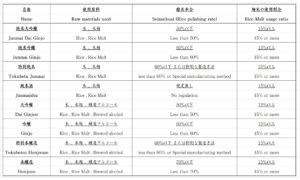
Looking at the figure above, you can see that DaiーGinjo has a lower rice polishing rate (many cuts) than Ginjo. Due to the time and effort it takes, DaiーGinjo has a cleaner taste with less unpleasant taste.
What is worrisome is Tokubetsu Junmai Shu sake and Tokubetsu Honjozo-shu. The rice polishing rate is 60% or less, or there is a special manufacturing method, but what exactly is “special"?
“澤乃井 特別純米 Sawanoi Toubetsu -unmai"
Actually, there are no detailed rules or regulations for this “special". This is the sake that each sake brewery has made with great care.
TokubetsuーJunmaiーShu has a stronger rice texture than Junmaishu, and many TokubetsuーHonjozoーShu have a firmer taste than Honjozo Shu. In order to understand why this sake is “Tokubetsu" compared to pure rice sake and honjozo-shu made in the same brewery, it is necessary to describe different ingredients and manufacturing methods.
5. List of types of sake
Based on the explanation above, we have compiled a list of the types of sake that have been broadly classified. Here, we will briefly introduce the characteristics and differences in taste of each. If you keep these eight in mind, it’s not frightening to talk about sake …!
(* Some items such as sake and grated sake can be further subdivided.)
① 純米大吟醸酒 JunmaiーDaiginjoーShu
Ingredients: water, rice, rice malt
Rice polishing rate: 50% or less
Junmai Daiginjo Sake, which uses rice that has been polished to the utmost limit, is a gentle drink that gives you a firm sense of the sweetness of the rice.
② 純米吟醸酒 JunmaiーGinjoーShu
Ingredients: water, rice, rice malt
Rice polishing rate: 60% or less
Since the rice polishing rate is lower than that of Daiginjo, it is easy to think that the quality will be reduced, but that is not the case. You can enjoy the contrast between the gorgeous aroma and the mellow taste unique to Junmai Ginjo.
③ 特別純米酒 TokubetsuーJunmaiーShu
Ingredients: water, rice, rice malt
Rice polishing rate: 60% or less or special manufacturing method
A special pure rice sake with refined and polished. Enhancing the taste and flavor of rice more strongly than Daiginjo and Ginjo.
④ 純米酒 JunmaiーShu
Ingredients: water, rice, rice malt
Rice polishing rate: No regulation
Junmaishu (usually 60-70%) has no specific rice-polishing ratio. Characterized by the strength of the waist, there are many types that go well with Kanzake.
⑤ 大吟醸酒 DaiーGinjoーShu
Ingredients: water, rice, rice malt, brewed alcohol
Rice polishing rate: 50% or less
Since the brewed alcohol used as a raw material has the effect of enhancing the aroma, you can enjoy a cleaner aroma than Junmai Daiginjo, which has the same rice polishing rate
⑥ 吟醸酒 GinjoーShu
Ingredients: water, rice, rice malt, brewed alcohol
Rice polishing rate: 60% or less
Fruity and smooth mouthfeel. Brewed alcohol is not intended to be replenished, so it is used in smaller amounts (same for Daiginjo).
⑦ 特別本醸造酒 Tokubetsu-HonjouzouーShu
Ingredients: water, rice, rice malt, brewed alcohol
Rice polishing rate: 60% or less or special manufacturing method
It is said that there are many sake breweries that make unique brewed sake by taking advantage of the characteristics of brewed alcohol that lighten the taste and produce aroma.
⑧ 本醸造酒 HonjouzoーShu
Ingredients: water, rice, rice malt, brewed alcohol
Rice polishing rate: 70% or less
The feature is that the amount of brewed alcohol used is determined not to exceed 10% of the weight of white rice used. It is a standard sake, and you can enjoy various ways of drinking such as normal temperature, hot sake, and cold sake.
